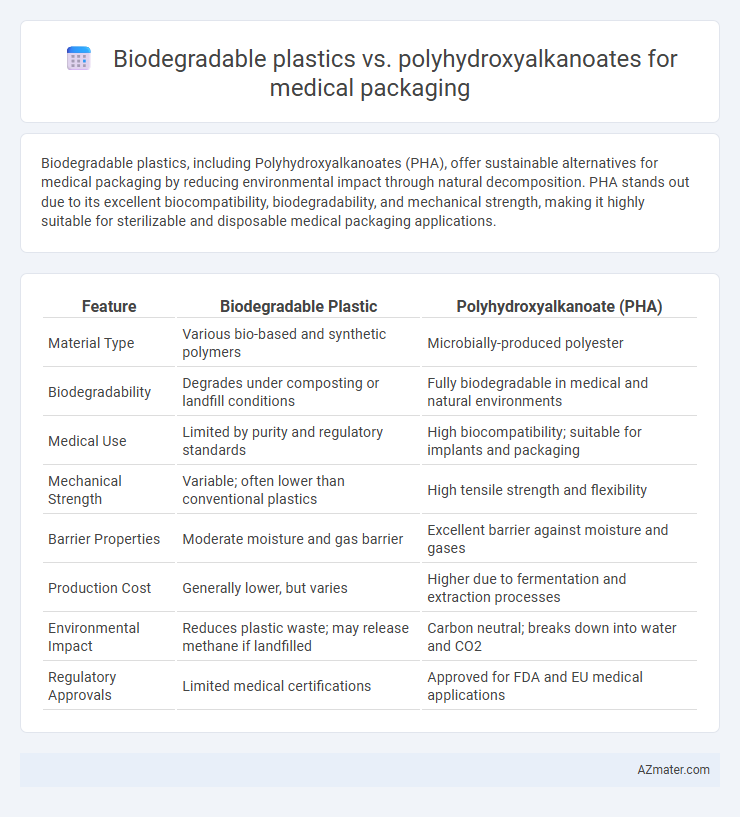Biodegradable plastics, including Polyhydroxyalkanoates (PHA), offer sustainable alternatives for medical packaging by reducing environmental impact through natural decomposition. PHA stands out due to its excellent biocompatibility, biodegradability, and mechanical strength, making it highly suitable for sterilizable and disposable medical packaging applications.
Table of Comparison
| Feature | Biodegradable Plastic | Polyhydroxyalkanoate (PHA) |
|---|---|---|
| Material Type | Various bio-based and synthetic polymers | Microbially-produced polyester |
| Biodegradability | Degrades under composting or landfill conditions | Fully biodegradable in medical and natural environments |
| Medical Use | Limited by purity and regulatory standards | High biocompatibility; suitable for implants and packaging |
| Mechanical Strength | Variable; often lower than conventional plastics | High tensile strength and flexibility |
| Barrier Properties | Moderate moisture and gas barrier | Excellent barrier against moisture and gases |
| Production Cost | Generally lower, but varies | Higher due to fermentation and extraction processes |
| Environmental Impact | Reduces plastic waste; may release methane if landfilled | Carbon neutral; breaks down into water and CO2 |
| Regulatory Approvals | Limited medical certifications | Approved for FDA and EU medical applications |
Introduction to Biodegradable Plastics in Medical Packaging
Biodegradable plastics in medical packaging offer sustainable solutions by decomposing naturally, reducing environmental impact compared to conventional plastics. Polyhydroxyalkanoates (PHAs) are a key type of biodegradable polymer known for their biocompatibility, making them ideal for sterile medical applications and packaging sensitive healthcare products. The integration of biodegradable plastics like PHAs enhances medical packaging by providing environmentally friendly protection while maintaining essential barrier properties.
What are Polyhydroxyalkanoates (PHA)?
Polyhydroxyalkanoates (PHA) are a class of biodegradable polymers produced by microbial fermentation of renewable resources, making them an eco-friendly alternative to conventional plastics in medical packaging. They exhibit excellent biocompatibility, biodegradability, and mechanical properties suitable for sterile packaging of medical devices and pharmaceuticals. PHA materials reduce environmental impact by decomposing into water and carbon dioxide without toxic residues, aligning with sustainable medical industry requirements.
Key Differences: Conventional Biodegradable Plastics vs PHA
Biodegradable plastics commonly used in medical packaging, such as polylactic acid (PLA) and polybutylene succinate (PBS), degrade through hydrolysis or microbial action but often require industrial composting conditions for efficient breakdown. Polyhydroxyalkanoates (PHAs), naturally produced by microorganisms, offer superior biocompatibility and biodegradability under diverse environmental conditions, making them ideal for medical applications requiring sterilization and stringent safety standards. PHAs exhibit enhanced mechanical properties, such as flexibility and barrier resistance, compared to conventional biodegradable plastics, aligning with the stringent demands of medical packaging for sterile, protective environments.
Environmental Impact of Biodegradable Plastics
Biodegradable plastics reduce environmental pollution by breaking down more quickly than conventional plastics, minimizing long-term waste accumulation in medical packaging applications. Polyhydroxyalkanoates (PHAs), a type of biopolymer derived from microbial fermentation, exhibit superior biodegradability and compostability under natural conditions, effectively decomposing into non-toxic byproducts. The adoption of PHAs in medical packaging significantly lowers carbon footprint and mitigates microplastic contamination compared to traditional biodegradable plastics, enhancing sustainable healthcare solutions.
Biocompatibility and Safety in Medical Applications
Biodegradable plastics such as polylactic acid (PLA) offer some degree of biocompatibility but often fall short in medical applications due to limited safety and potential for toxic degradation products. Polyhydroxyalkanoates (PHAs), by contrast, demonstrate superior biocompatibility and non-toxicity, making them ideal for sensitive medical packaging that requires direct contact with pharmaceuticals or biological tissues. PHAs degrade into non-harmful metabolites like hydroxybutyrate, ensuring safety and minimizing inflammatory responses, which is critical in sterile medical environments.
Barrier Properties and Shelf Life Comparison
Polyhydroxyalkanoates (PHAs) exhibit superior barrier properties compared to conventional biodegradable plastics, offering enhanced resistance to moisture and oxygen transmission essential for medical packaging applications. This improved barrier performance significantly extends the shelf life of sensitive medical products by maintaining sterility and preventing microbial contamination. The inherent biodegradability of PHAs combined with their excellent barrier characteristics makes them a preferred material for sustainable, high-performance medical packaging solutions.
Sterilization Methods for Biodegradable Plastics and PHA
Sterilization methods for biodegradable plastics and polyhydroxyalkanoates (PHA) in medical packaging must maintain material integrity while ensuring microbial safety. Gamma irradiation and ethylene oxide are commonly used for PHA due to their ability to sterilize without significant polymer degradation, whereas steam sterilization often degrades many biodegradable plastics. Selecting appropriate sterilization techniques is critical for preserving the mechanical properties and biocompatibility of medical-grade biodegradable packaging materials.
Regulatory Approvals and Standards in Medical Packaging
Biodegradable plastics and Polyhydroxyalkanoates (PHAs) in medical packaging face stringent regulatory approvals from agencies such as the FDA and EMA, requiring compliance with ISO 10993 for biocompatibility and USP standards for safety and efficacy. PHAs often demonstrate superior alignment with medical-grade requirements due to their inherent biocompatibility and biodegradability, accelerating regulatory acceptance in sterile packaging applications. Both materials must meet FDA 21 CFR Part 177 regulations for food contact substances when applied to medical packaging that interfaces with consumables or pharmaceuticals.
Cost Considerations and Market Availability
Biodegradable plastics for medical packaging vary in cost, with conventional options generally more affordable than polyhydroxyalkanoates (PHAs), which are still relatively expensive due to complex fermentation processes and limited large-scale production facilities. Market availability of PHAs is constrained by niche manufacturing and supply chain challenges, whereas biodegradable plastics like PLA and PBAT benefit from established production and broader distribution networks. Cost considerations heavily influence adoption in the medical packaging sector, where PHAs offer superior biodegradability but face economic barriers compared to more accessible biodegradable polymers.
Future Trends: Sustainable Medical Packaging Solutions
Polyhydroxyalkanoates (PHAs) represent a leading future trend in sustainable medical packaging due to their complete biodegradability and biocompatibility, which reduce environmental impact and support medical safety standards. Biodegradable plastics derived from renewable resources are increasingly engineered to enhance barrier properties and mechanical strength, meeting stringent regulatory demands for sterile medical environments. Innovations in PHAs and advanced biodegradable composites are driving the shift towards eco-friendly packaging solutions that align with circular economy goals in healthcare industries.

Infographic: Biodegradable plastic vs Polyhydroxyalkanoate for Medical packaging
 azmater.com
azmater.com